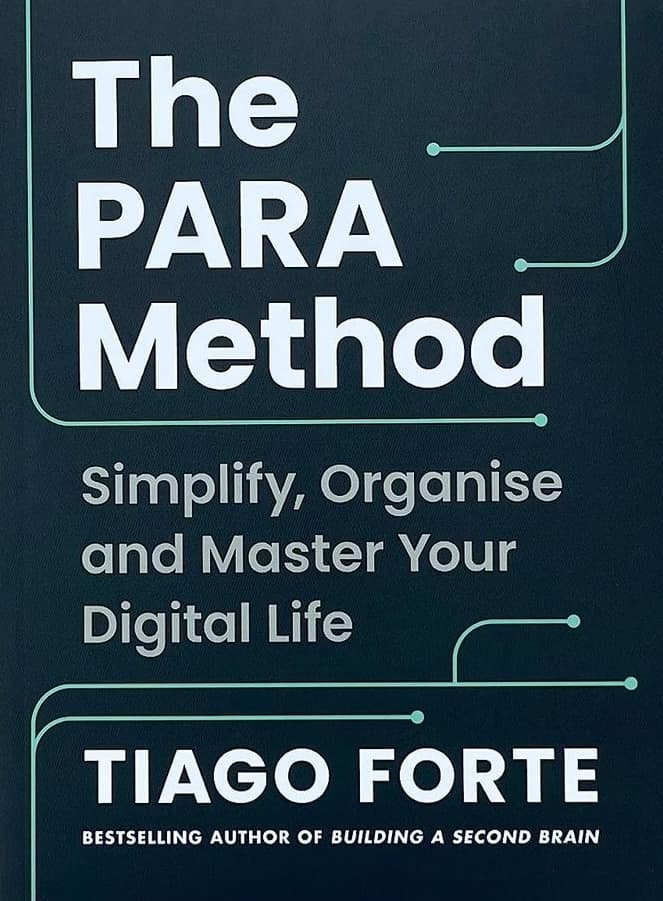- Author: Tiago Forte
- Publisher: Simon Element / Simon Acumen
- Rating: ⭐⭐⭐⭐⭐
- Link Amazon : Book The PARA Method
- Pages: 208
- Time to Read: 8 Days
🚀 The Book in 3 Sentences
- PARA is a method to organize things based on their actionability.
- The goal of PARA is to stop overengineering organizing and start being productive.
- PARA can be used for files, notes, images, and much more.
🕵🏼Who Should Read It?
I have seldom found a book that would be helpful for as wide a range of people as this one. Everyone uses a note-taking app, a storage app, a folder system, or something similar, which is why this book and the method it teaches are helpful for many people. Additionally, the book is written in such a clear and straightforward way that it's a very easy read.
☘️ How the Book Changed Me
As soon as I read the book, I started to implement the PARA folder structure suggested by the book's method. Right away, I felt a sense of relief as my folders became more structured and organized with the goal of action-taking in mind. Because of the book, I not only changed the way I structured my folders but also switched my note-taking system from Notion to Obsidian. There, I implemented the same PARA note structure, which helped simplify my system immensely.
✍️ My Top 3 Quotes
"Getting organized, in my opinion, is about acquiring power" Tiago Forte
"Sometimes organizing information too much makes it less valuable" Tiago Forte
📒 Summary + Notes
The concept provided in this book is pretty simple and easy to implement. The book provides a method with which to organics notes, folders and other informations like files.
The Goal
The goal of the PARA method is to organize your files in order of actionability. This means items higher up in the structure (notes, folders, or files) are visited and used more frequently than those lower down the list. This sorting by actionability leads to organizing information that is used the most to be the most easily accessible. The goal of a system should be to improve productivity and actionability.
PARA
PARA is the main concept of the book. It is the structure/system taught in this book.
0 - Inbox
This is the folder where newly added files, notes, or images go if it's unknown where they belong at the time. From there, they will be placed into their right place.
1 - Projects
Short-term efforts in your work or life that you're working on now. Projects have a goal which will make it possible to mark them as completed. They also have a timeline or timeframe by which the project will be done. Projects fall under specific areas. For example, "Creating a Landing Page" could fall under the area "Development".
2 - Areas
Long-term responsibilities you want to manage over time. An area of responsibility has a standard to be maintained and an indefinite end date.
3 - Resources
Topics or interests that may be useful in the future. Tiago explains resources as follows: "Resources encompass the vast number of things you might be interested in, curious about, or passionate about at any given time." For every resource or piece of information, you should ask yourself the question: "Is this useful?" instead of "Is this interesting?" to prevent over-collecting.
4 - Archives
Inactive items from the other three categories.

Where to put a piece of information graphic
The Sixty-Second PARA Setup Guide
Tiago has implemented the PARA Method with many clients and has found that it's best to treat and start the system like a plant. That means you start small and only with the things you use, then with time add more things and make the plant grow.
Step 1: Archive existing files Tiago says that the best way to start with the PARA method is to start from scratch and with peace of mind. He suggests moving all previously stored files into a folder named "Archive [Today's date]" and then moving on. This newly created folder is then placed into a parent folder named "4 - Archive" which is used like cold storage.
Step 2: Create project folders Next come the projects. Tiago puts this as the second step because projects are things you are actively working on. That means they will, by definition, be more likely to be timely and pressing. In this step, create a "1 - Projects" folder where all your projects are stored in one place. Folders in this could look like "Complete webpage design", "Buy new computer", "Write research report". These folders will be visited most often.
Step 3: Create additional folders as needed This is the step where you now create areas in the "2 - Areas" and resources in the "3 - Resources" folders. But Tiago only suggests adding the folders if you have information to put there. He advises against creating ghost folders.
Naming Convention
Tiago names some naming conventions to make things even more findable:
- Emojis at the beginning of titles for project folders - ⚡Finish Landing Page
- Capitalized titles for area folders - Development
- Uncapitalized titles for resource folders - nextjs single page architecture
I really advise you to try the PARA method and see what effect it has on your productivity. Also be sure to read the book if you want to go in depth about PARA method. I want to thank you for reading this blog. I wish you all the best.
Regards,
Devin Hasler

